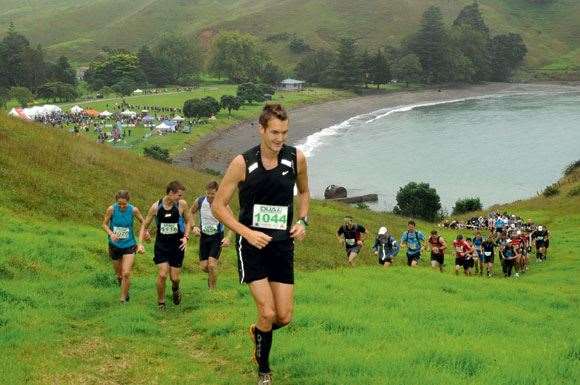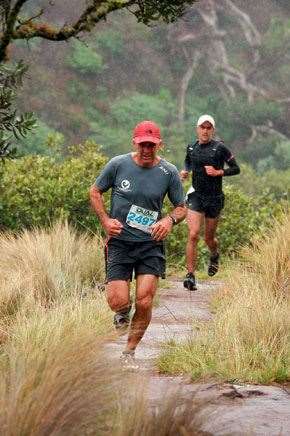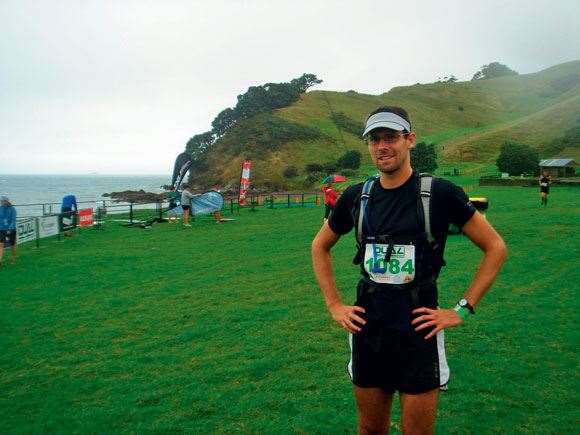New Zealand’s breathtaking Motutapu and Rangitoto Islands offer a great jogging alternative to dreary city footpaths.
New Zealand’s breathtaking Motutapu and Rangitoto Islands offer a great jogging alternative to dreary city footpaths.
 The green hills of Motutapu.
The green hills of Motutapu.Images: SuperSport Images
If you’re a road runner, a jogger who pounds out your clicks on concrete footpaths, you’ll probably think this sounds like bunkum. And from my experiences of road running I’d agree. Running on concrete foot paths is not fun. It powders your joints and flays your muscles and numbs your mind. Sometimes, when I was training for a road marathon a few years back and my breath was tearing at my throat and my right ankle was aching and my lower back was throbbing, I could actually feel little knots of stress tightening in my neck.
But running off-road is something else altogether. Comparing bush trails to concrete foot paths is like comparing the beach to an indoor pool. The bush is engaging and faceted and constantly changing. Instead of pawing the uniform hardness of concrete, you can feel the different types of ground under your feet; the textures of sand, mulch, grass, packed earth, stones, rock. Instead of holding the uniform pace of the road, you need to be flexible; sometimes scrambling up steep climbs, sometimes tip-toeing rough sections of track, sometimes walking up rough, steep climbs. And instead of slotting into the mindless grind of the road, you actually have to look where your feet are falling. Sometimes you need to dance over jagged rocks, hurdle coils of roots, duck under low branches. Sometimes the track turns loose and sandy and you need to get on your toes. Sometimes the path opens out and you can lift the knees and lengthen the stride.
For all this, time seems to melt away in the bush; while a half-hour road run can seem endless, chunks of time simply vanish in the bush. This is why road running is something to endure, while bush running is something to savour. At least for two hours, maybe three. But beyond that? Well, that was uncharted territory for me. And that’s why I signed up for an off-road marathon – I wanted to know how long the good vibes of trotting through the bush lasted.
 This isn’t just another road run
This isn’t just another road runImages: Supersport Images
The Dual marathon (so named because the day also includes mountain bike races) snakes its way around Motutapu and Rangitoto, a pair of islands joined by a slender concrete causeway that stand at the opening to Auckland’s Waitemata Harbour. When Maori wakas first nosed into these waters 800 years ago, Motutapu stood alone. Its hills were covered in pohutakawa forests that rang with the ragged shrieks of the kawa parrot and the black-backed gull. The Maori set up camp and eked out a pleasant existence, snaring the birds in the dark, dripping forests. For 200 years this was how life went on. Then Rangitoto emerged. The volcano bubbled from the sea in a frothing miasma of steam and sulphur, drenching Motutapu in foul ash, killing the forests and driving the settlers onto the mainland. You can only imagine the looks on the Maori faces when this smoking shield of land rose from the sea. It must’ve been a hellish scene.
As our ferry battles a ragged swell tumbling in from the north, the faces of the runners look similarly troubled. To the east, Rangitoto is a circular spill of basalt arcing up to its 261m peak, its slopes dark with pohutakawa trees. To the west, Motutapu is a sharp rumpling of hills stripped of trees and covered with pale grey heather. Above the forests of Rangitoto the gulls wheel in tired circles, on the slopes of Motutapu cows cluster in forlorn crowds. Little wonder the animals look unimpressed: a biting nor’easter is raking across the islands, driving before it a hard, cold rain that clatters against the windows of the ferry. The black peak of Rangitoto is lost in cloud. The folds of Motutapu are filled with a cold mist. The runners peer through the windows with narrowed eyes.
The route begins at a pebbly bay on the west coast of Motutapu and immediately switchbacks up a nasty climb before describing a vague figure-eight traverse of the islands. It’s a route that alternates from grass, to gravel, to basalt, to grass, to sand, and, inevitably, to mud. It crosses the highest points of both islands and snakes up every other slope it can find. Stacking every climb on top of one another, the route encompasses a vertical ascent of 1103m – roughly the same as starting at Jindabyne and climbing to the peak of Kosciuszko. A final email sent to all competitors on the eve of the race notes that the median finishing time from last year’s race was a tick under five and a half hours. Beneath is a warning in bold type: “Please don’t come over thinking this is just another road run, as you will have a very tough day – please reassess your goal times, be realistic and be prepared to be out on the course for longer than you think.”
This warning fills my thoughts as we cluster at the start line. The ground is already alarmingly boggy. The rain’s hitting us like handfuls of gravel. On the horizon the sea and sky meld together in a dull, grey mess. We hug our elbows and grin nervously at one another ‒ we may be out on the course for much longer than we thought. But despite the trepidation, the race starts easily enough. Partly this is because marathons invariably start easily enough, and partly it’s because the wind is tearing over our right shoulders, giving us a generous hand in the back. We crest the highest point of Motutapu and cut down to its southern shore, working over the grassed spurs that run into the sea.
Then, after half an hour of pleasant toil, we turn left and cross a rough concrete path where a sodden Maori woman beams at us. “Welcome to Rangi!” she says to every passing runner. And with these words the problems begin. The open hills give way to a tortuous single-track carved out of the forest; the spongy grass gives way to a hard-scrabble floor of jagged basalt. Progress slows to a crawl as we climb toward the summit of the volcano. We form a tight queue, hemmed in by the trees, stymied by the rocks. Any attempt to run is an open invitation for a twisted ankle or a sprung knee. I move at an awkward chimp-lope, wincing as deep bruises take root beneath the balls of my feet. A woman pulls to the side of the track, rubbing her left knee. “This is inhumane,” she mutters. At the peak of the island the trees open to an impenetrable fog. “Well,” comes a cheery Kiwi voice behind me, “that was the view, hope you enjoyed it.” The track arcs downwards and the basalt footing becomes even more ragged. The pace slows again.
I’m picking my way along the shore when an unseen tree branch, furred with moss and as thick as my leg, collects the crown of my head. It makes an impressive thud and sends me staggering backwards. I suppress a wild urge to scream a word I can’t put in print. “Ooh, you alright?” comes a chuckling voice from behind. I don’t answer. I’m over it. My feet are aching and my head’s ringing. I’m of a good mind to duck off and join the half-marathoners. But, oddly, this moment proves to be the hinge my race turns on. Within a handful of strides, the forest opens, the basalt crumbles to fine gravel. The track turns right, crosses the concrete path, and I’m back on the blessed grass of Motutapu.
And from here my rhythm returns. The pain in my head eases, the bruises on the soles of my feet fade. As we track up the west coast of the island, past black-sanded beaches and old concrete bunkers from the Second World War, I begin to pass runners, one by one. I’m coasting on an occult wave of energy. I spot runners on distant hills and hunt them down. My stride feels free, my shoulders loose. Surely this can’t last?
 Trail running makes your author happy.
Trail running makes your author happy.Images: SuperSport Images
But it does. Four and a half hours in, I crest a ridge and am stunned to see the finish line a few hundred yards away. I blink. I’d expected to be out here, in the rain and the mud, climbing up and down the heathery rises for another hour at least. I check my watch again and shake my head. I’m truly sorry the whole thing’s over. I’ve got half a mind to turn around and find another grassy hill to scale. Mawkish, I know, but true.
– Aaron Scott
Related Articles

Folau begs fans to fund his $3m fight to keep his $4m contract

Folau: This was my Christian duty...













